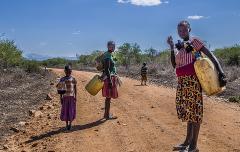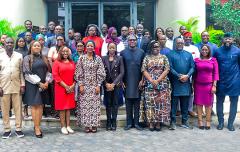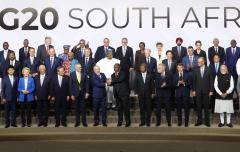Powering Progress: 7 Opportunities to Close the Energy Access Gap and Accelerate the Clean Energy Transition Now
Universal access to affordable, reliable, sustainable, and modern energy by 2030 (SDG7) is within reach, but only if we find ways to unlock and accelerate investments where they are needed most, fueling inclusive growth and shared prosperity.
The Tracking SDG7: Energy Progress Report 2025 unveiled this week, points to the risk of leaving millions without clean and sustainable energy. According to the report, the number of people without electricity stands at 666 million,19 million fewer than the previous year, while progress on clean cooking has largely stagnated, with roughly a quarter of the world’s population, around 2.1 billion people remaining dependent on polluting fuels and technologies.
At the same time, the report indicates that the energy transition is not progressing fast enough to accomplish international climate and development objectives. A successful global energy transition depends on where the next billion people get their electricity and how they consume this electricity. If these communities are powered by coal and diesel, and do not utilize energy efficiency measures, the climate goals of Paris and beyond will fail.
While the 2025 report highlights areas where the world is off track, it also offers a blueprint for action. Here are seven key opportunities we see for accelerating progress towards SDG7.
1. Expand Decentralized Renewable Energy Solutions
The 2025 report shows that rural areas continue to bear the brunt of the electricity access challenge, with 84 percent of those lacking electricity living in rural communities. Moreover, the report shows that decentralized renewables are often more fit-for-purpose in remote areas.
Therefore to close the gap,reach universal electricity access and ultimately industrialize, we see an opportunity in investing in solar home systems, mini-grids, and off-grid solutions focused on productive use for rural communities.
At SEforALL, we manage the Universal Energy Facility (UEF), which is a multi-donor results-based financing (RBF) facility designed to pool funding from various partners and ensure ongoing delivery of energy access programmes. Since its launch in 2020 with an initial capitalization of USD 8.5 million, the UEF has grown into a USD 67.3 million facility and currently operates in six Sub-Saharan African countries and provides RBF grants to developers of green mini-grids, and standalone solar systems for productive use. The solutions we promote create local jobs, improve resilience, and reduce reliance on diesel and biomass.
2. Triple Renewable Energy Capacity
Sustained action is needed to drive the uptake of renewable energy solutions, and the 2025 report indicates that current ambitions fall short of achieving the COP28 goal to triple global renewable power capacity by 2030. The gap risks slowing the penetration of renewables and electrification in key sectors such as industry, transport, and buildings, sectors that are critical for increasing the overall share of renewable energy.
We see an opportunity to accelerate electrification and renewable energy deployment to align with the COP28 target and advance the broader energy transition outcomes envisioned.
Emerging economies have vast potential in wind, solar, hydro, and geothermal energy. Realizing this potential requires targeted policies that improve access to financing, support technology and knowledge exchange, and build local capacity, which are key to achieving equitable energy access and sustainable economic growth.
3. Double the Rate of Energy Efficiency Improvements
SDG7 calls for doubling the rate of global improvement in energy intensity by 2030, relative to the 1990-2010 average. Sluggish global progress in recent years means that energy intensity will have to improve by 4 percent per year on average in order to meet the original SDG 7.3 target. This is consistent with the goal of doubling the global average annual rate of energy efficiency improvement by 2030 agreed on at COP28.
We see an opportunity in implementing stronger policies and incentives to scale up efficiency gains in buildings, transport, and industry. Although current improvement is only 0.8%, technical potential is high. Digital tools, smart meters and updated building codes are underused levers.
SEforALL, working with the Government of India and an ecosystem of partners - including the Bureau of Energy Efficiency of India, the Alliance for an Energy Efficient Economy and the International Energy Agency - has developed a Voluntary Action Plan on doubling the global rate of energy efficiency improvement by 2030, that outlines potential measures along key pillars such as energy efficiency financing and sustainable consumption patterns, to be implemented in line with national goals and objectives.
4. Leverage Clean Cooking as a Health and Gender Equity Solution
The 2025 report shows that roughly a quarter of the world’s population remains dependent on polluting fuels and technologies for cooking, and if current trends continue, only 78 percent of the global population will have access to clean cooking by 2030. This shortfall would leave nearly 1.8 billion people without clean cooking fuels and solutions.
We see an opportunity in mobilizing multi-sector investment into clean cooking solutions. The recent Summit on Clean Cooking in Africa shows donor interest and policy momentum. The Summit, which mobilised USD 2.2 billion in financial pledges from governments and the private sector, included a pivotal announcement by SEforALL and the World Food Programme (WFP) on an innovative partnership that will bring clean and efficient cooking solutions to schools in Africa, helping them shift away from polluting and harmful cooking methods currently used for preparing student meals.
Working with the Government of Tanzania and the UK-funded Modern Energy Cooking Services (MECS) programme, the project kicked-off in Tanzania, where the first model eCooking kitchen in Kibasila Primary School was officially inaugurated in July 2025. The initiative aims to expand to up-to 50 grid-connected primary schools. Using learnings from Tanzania, SEforALL, WFP and partners will also explore opportunities to scale the initiative globally.
5. Expand Results-Based and Innovative Financing Models
The SDG7 Tracking Report 2025 estimates that annual investments between USD 4.2 and 4.5 trillion are needed to achieve SDG7 targets by 2030.
We see an opportunity for sector players to deliver investment to those who are most-in-need. This can be done through reforming multilateral and bilateral lending to expand the availability of public capital; mobilizing more concessional finance, grants, and risk mitigation instruments to attract private sector capital; improving risk tolerance among donors; and enacting appropriate national policy frameworks, regulations, and reforms through integrated and rigorous planning.
At SEforALL, we are working with the World Bank, the African Development Bank, the Rockefeller Foundation and the Global Energy Alliance for People and Planet to implement Mission 300, the ambitious initiative to electrify 300 million people by 2030. To help achieve this objective, SEforALL is collaborating with partners to develop innovative financing instruments to enable private participation in local currency financing platforms with an aim to create a new pan-African local currency mechanism that will not only protect local investors from the risks associated with the volatility of currency markets, but also lays the groundwork to unlock currently unavailable sources of capital for developers across Africa.
In March this year, together with Nigeria Sovereign Investment Authority (NSIA), Africa50, and International Solar Alliance (ISA), we unveiled the USD 500 million DRE Nigeria Fund, which is the first country-focused DRE fund established under the DRE Africa Platform that will develop and invest in distributed renewable projects across Africa.
6. International Cooperation and Dialogue to Unlock Financing
International cooperation and dialogue are more critical than ever to advance energy action aligned with SDG7.
The UN General Assembly’s decision last year to extend the UN Decade of Sustainable Energy for All to 2030 provides an important platform to mobilize a final push towards SDG7. Importantly, the review of SDG7 at the HLPF 2026 will be a unique opportunity to strengthen international cooperation on energy and its interlinkages, and to consider potential building blocks that could inform the intergovernmental discussions on a post-2030 development framework, which will be initiated at the SDG Summit 2026.
Here, we see an opportunity for the multilateral institutions, and the global community to step up efforts with bold, collaborative action to unlock the trillions sitting in global financial markets and channel them toward the world’s most underserved.
7. Harness Digital and Data Technologies
The 2025 report shows that improved data on energy access gaps, cooking usage, and performance can sharpen policy and funding.
We see an opportunity to deploy digital platforms, satellite mapping, and smart meters to better target interventions. Further, open data tools (like those highlighted in the 2025 report) enhance transparency and accountability.
At SEforALL, we believe that integrating AI in the energy sector planning and evidence – especially for developing countries, will go a long way in designing comprehensive solutions for many of the developmental challenges currently facing those in developing countries. In collaboration with IBM, we developed the Open Building Insights (OBI) Tool, which is helping energy planners overcome critical data gap challenges to inform energy access and energy transition interventions and better deliver results for those most in need.
The global community has the tools, finance models, and technology to make SDG7 achievable by 2030. The seven opportunities that we have highlighted, if acted upon now, can deliver huge co-benefits for development, climate, health, and jobs.
Read the Tracking SDG7: Energy Progress Report 2025: https://trackingsdg7.esmap.org/downloads
Photo credit: P. Vasic/UN DESA




